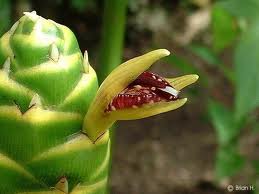Zingiber
Pot Cultivation
In warmer regions, Ginger should be grown in light shade, but in northern gardens it should be grown in full sun. It should be given plenty of water. When they are grown in containers in the North, they should be moved into a cool storage area before frost. Let the tops of the plants dry and turn yellow after which they are trimmed off. They should be watered every month just to keep the roots from drying out. When spring arrives, they can be moved to a sunny, sheltered place to start top growth. More than one plant should be grown so you can have starter roots for the next year's plants. To harvest these, the roots may be dug with a spading fork just before frost. To harvest from containers, dump out the roots or feel for them with your hands. Store them at room temperature. Ginger root may be grated or sliced for fresh use in stir-fry recipes, or crystallized. They may also be dried and ground to produce the well-known spice.PROPAGATED: Pieces of root may be placed in a shallow 5 to 10 gallon container of potting soil or sand. After they sprout and form a good root system, they may be transplanted to the garden and spaced 12 inches apart.
 |
Z. officinale. |
VARIETIES
- Z. officinale.




